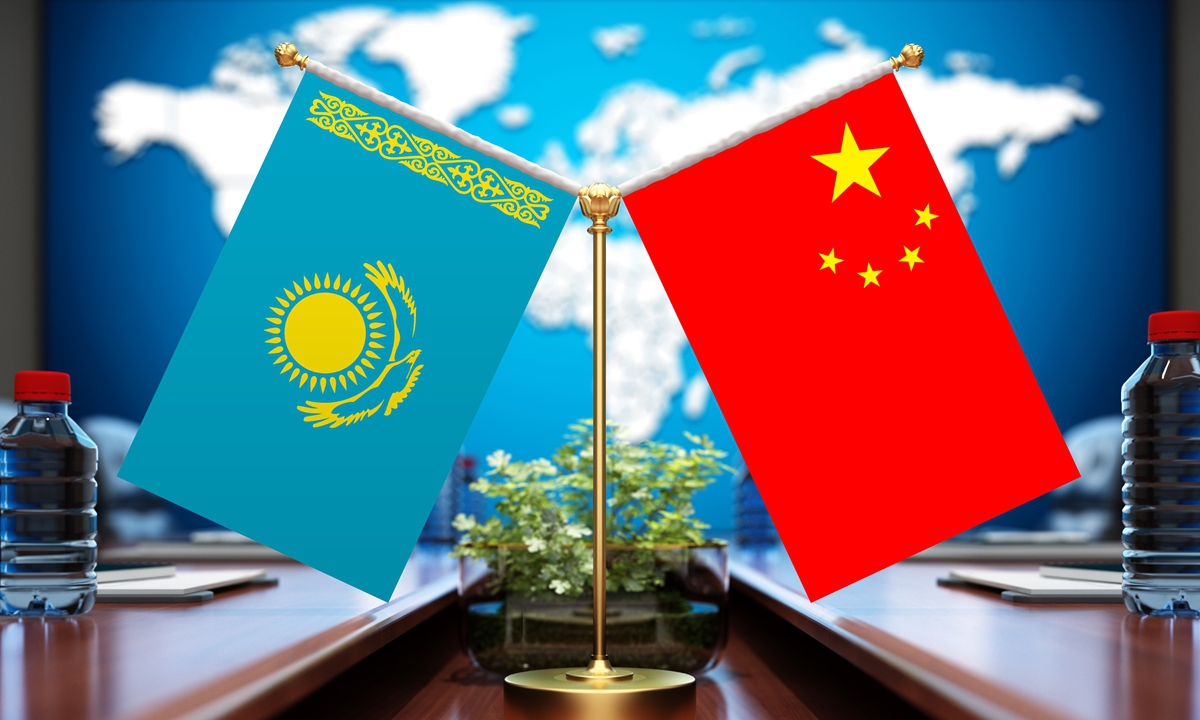
China Kazakhstan Photo:VCG
Crude oil and natural gas projects between China and Kazakhstan in the past decade have played a significant role in safeguarding China's energy security and elevating the economic development of Kazakhstan as well as the Central Asian region, high-level executives and business representatives from China and Kazakhstan told the Global Times.
The comment was made during Chinese President Xi Jinping's ongoing visit to Kazakhstan. Industry insiders said the visit could consolidate the two countries' comprehensive cooperation momentum across multiple sectors, including energy which serves as the cornerstone of flourishing bilateral economic relations, while also leading to more investments in solar power, new-energy vehicle and other green energy sectors.
China National Petroleum Corporation (CNPC) has signed relevant agreements with Kazakh companies on Tuesday during the 7th meeting of the China-Kazakhstan Entrepreneurs Committee held in Kazakhstan on Tuesday, according to a statement on CNPC's website on Wednesday.
Almassadam Satkaliyev, Kazakhstan's Minister of Energy, said at the meeting that the future prospects for cooperation between the two countries are broad, and both countries will further deepen exchanges and cooperation in the entire oil and gas industry chain, making greater contributions to building a new "golden thirty years" of cooperation in China-Kazakhstan relations.
One of the most important achievements in China-Kazakhstan energy cooperation in the past decades centers on two projects - the China-Central Asia natural gas pipeline and the China-Kazakhstan oil pipeline.
To date, the natural gas transmitted by the China-Central Asia natural gas pipeline A/B/C line - which runs through Turkmenistan, Uzbekistan, Kazakhstan and China and makes resource-rich Kazakhstan a main natural gas supplier to China - has reached about 500 million Chinese in 25 provinces and municipalities as well as the Hong Kong Special Administrative Region, Huang Hongxing, general manager of Kazakhstan-China gas pipeline project under Trans-Asia Gas Pipeline Company, told the Global Times. The natural gas pipeline has been running for 15 years.
The company is a joint venture set up by Chinese and Kazakh firms.
Kaiypov Yerseiit Zholmyrzauly, chairman of the management board of Asian Gas Pipelieng LLP, a Kazakh-China joint venture, told the Global Times that the designed annual gas transmission capacity of the natural gas pipeline is 55 billion cubic meters.
Also, in the past decade, the China-Kazakhstan oil pipeline, China's first overland crude oil import passage, has shipped over 150 million tons of oil to China to date, according to public data. The oil pipeline, which runs from Kazakhstan's Caspian shore to Northwest China's Xinjiang Uygur Autonomous Region, was put into operation 20 years ago, Huang said.
He noted that the two pipelines are of great importance to China, as they have been ensuring a stable and safe crude oil and natural gas supply.
"The two projects constitute the northwestern pillar of China's four energy passages, and they're implemented at quite an early stage compared with the other two overland pillars, further safeguarding China's energy security," Huang said.
According to Huang, taking account of China's sheer size of population and large industrial base, the country has a huge energy demand which domestic supply is apparently lacking. It is estimated that over 70 percent of China's crude oil relies on imports, while the figure for natural gas was around 40 percent, according to media reports.
With regards to the projects' benefits to Kazakhstan, the two executives also highlighted how the thriving energy cooperation with China has been helping the Central Asian country to diversify export channels and integrate into a larger energy market.
"Before the implementation of the two flagship projects, Kazakh oil and natural gas only had one export destination: Europe," Huang explained. He also noted that the two major oil refineries are located in Kazakh central and northeastern regions, whereas the western Caspian shore is the place with rich oil reserves. This means the build-up of the pipeline also meets Kazakhstan's need to link up the downstream, midstream and upstream of the oil production chain.
According to Kaiypov, the wider use of natural gas also aligns with the green energy development goals of both China and Kazakhstan.
"In Almaty, the largest city of Kazakhstan, authorities are replacing thermal power plants with natural gas amid a nationwide push," Kaiypov said. He also stressed that the pipeline's operation and maintenance has driven the fast-lane development of related manufacturing and service sectors in Kazakhstan, offering a great boost to the local economy.
Local businesses have described the two pipelines as the "new silk road of energy," which embodies the connectivity of the Belt and Road Initiative (BRI) in terms of trade, infrastructure, policy, finance and people-to-people exchanges, the Global Times learned. The two projects are also vivid examples of how cooperation between China and Central Asia complements each other's advantages, leading to a win-win result.
Last year, China proposed to forge a China-Central Asia energy development partnership, increase oil and gas trade, develop energy cooperation across the industrial chain and boost cooperation in new energy and for the peaceful use of nuclear energy, among other priorities.
According to a statement the China Chamber of Commerce in Tajikistan sent to the Global Times, in terms of the broader energy cooperation between China and Central Asia, the ties are solid and have rosy prospects, not only in traditional energy but also in new energy, solar power and clean energy cooperation.




